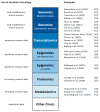The Need for Multi-Omics Biomarker Signatures in Precision Medicine
- PMID: 31561483
- PMCID: PMC6801754
- DOI: 10.3390/ijms20194781
The Need for Multi-Omics Biomarker Signatures in Precision Medicine
Abstract
Recent advances in omics technologies have led to unprecedented efforts characterizing the molecular changes that underlie the development and progression of a wide array of complex human diseases, including cancer. As a result, multi-omics analyses-which take advantage of these technologies in genomics, transcriptomics, epigenomics, proteomics, metabolomics, and other omics areas-have been proposed and heralded as the key to advancing precision medicine in the clinic. In the field of precision oncology, genomics approaches, and, more recently, other omics analyses have helped reveal several key mechanisms in cancer development, treatment resistance, and recurrence risk, and several of these findings have been implemented in clinical oncology to help guide treatment decisions. However, truly integrated multi-omics analyses have not been applied widely, preventing further advances in precision medicine. Additional efforts are needed to develop the analytical infrastructure necessary to generate, analyze, and annotate multi-omics data effectively to inform precision medicine-based decision-making.
Keywords: epigenomics; genomics; integrated multi-omics; metabolomics; precision medicine; precision oncology; proteomics; transcriptomics.
Conflict of interest statement
The authors declare no conflict of interest.
Figures
References
Publication types
MeSH terms
Substances
Grants and funding
LinkOut - more resources
Full Text Sources
Other Literature Sources
Medical
Research Materials


